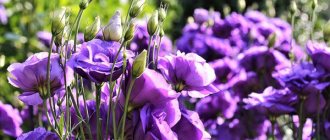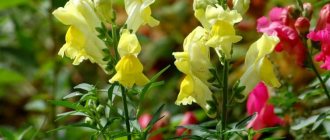Author: Elena N. https://floristics.info/ru/index.php?option=com_contact&view=contact&id=19 Category: Garden plants Published: January 25, 2019Last edits: November 03, 2020
- How to grow eustoma
- Homemade eustoma
- Tall garden eustoma for cutting
Why do gardeners love eustoma so much? For a stunning aroma in the front garden, for beauty comparable to a rose, for long (up to three weeks!) freshness when cut. In the 80s, the Japanese drew attention to a wild flower from the Indian prairies. It was they who gave the world hundreds of varieties and types of eustoma: summer and autumn, potted and garden, terry and bells, tall and dwarf, monochrome and two-color... April 1 - this is the date experienced flower growers call ideal for planting eustoma (seedlings) in the ground in the middle strip, regardless of the weather. And it's not a joke. The thing is that during the first months of life, eustoma develops very slowly, which means that both vigorous weeds and the first heat can easily destroy the baby! Early planting gives the delicate plant a chance to gain strength before the active growth of weeds and the start of intense heat.
- What other tricks might be useful to those who want to grow their own eustoma?
- What determines the flowering period of eustoma?
- What to do if the eustoma has bloomed before the end of “its” season?
Read our article.
Planting and caring for eustoma
- Planting: sowing for seedlings - in late February-early March. Planting seedlings in the garden - three months after germination.
- Flowering: second half of summer.
- Lighting: shade or partial shade.
- Soil: dry, loose, light, well-drained, neutral reaction.
- Watering: scanty, but regular. The best method of watering is drip.
- Fertilizing: with complex mineral fertilizers twice a month.
- Reproduction: seed.
- Pests: thrips, whiteflies, spider mites and slugs.
- Diseases: false gray rot, fusarium, late blight, powdery mildew, root rot, tobacco mosaic virus.
Read more about growing eustoma below.
Eustoma (lat. Eustoma) , also called lisianthus ( lat. Lisianthus - bitter flower), or “Irish rose”, or “Texas bell”, or “Japanese rose”, belongs to the Gentian family. Translated from Latin, “eustoma” literally means “beautiful mouth,” and in a more literary version, “beautifully speaking.” The homeland of eustoma is considered to be the south of North America, Mexico, the north of South America and the Caribbean islands. An American Indian legend says that eustoma first bloomed on the grave of an innocent girl killed by the spirit of war because she refused to become his wife. Irish doctor and botanist Patrick Brown discovered eustoma for Europeans.
The plant is very popular among flower growers as a cut plant, since freshly cut eustoma can stand in a vase with water for up to three weeks. It has been cultivated as a houseplant since the nineties of the last century.
- Nolina – care, photos, types
Where are you from, beautiful flower?
Do you know that there are a lot of myths, beautiful and often sad legends associated with plants, trees, and flowers? Why our ancestors created these stories thousands of years before us, we do not know. Some will say that this is fiction, but others believe that everything was different before. There is a beautiful and sad legend about the wonderful eustoma, the agricultural technology of which we will look at a little later.
Many centuries ago, Indian tribes lived on the American continent. The leader had a beautiful daughter who was not destined to live long. This is because the evil spirit of war fell in love with a beautiful maiden and wanted to make her his wife. But the beauty refused the deity, and he turned his anger on her. The leader's daughter was killed, she was buried, and a day later the grave was decorated with beautiful flowers - eustomas.
On a note! The flower has many names like no other. For example, Americans call eustoma Irish rose, gentian tulip, in Japan - Japanese rose, in Mexico - Texas bell.
Nowadays, there is debate about when eustoma was discovered. There are two main versions. According to one of them, the flower was first described by Carl Lineus, calling it sublime gentian. But, according to other scientists, it was not Lineus who was the first, but a doctor and botanist from Ireland, Patrick Brown. Further, scientists from other countries began to describe eustoma, the second name of which is lisianthus. Let's take a closer look at the species and then move on to its agricultural technology.
Botanical description
The stems of eustoma are strong, almost a meter high, but graceful, like a carnation. From the middle, the stems begin to branch, so the branch is a whole bouquet, which can contain up to 35 buds, blooming one by one. The leaves of eustoma have a grayish or bluish tint, they are lanceolate-oval, matte, as if made of wax. The calyx of the flower is funnel-shaped, large and deep. Eustoma flowers, double and non-double, 5-8 cm in diameter, in different shades - pink, lilac, white, purple, plain or with a contrasting border. When the eustoma bud is half-opened, it looks like a rose, but when the flower opens, it resembles a double poppy.
Eustoma is a biennial plant in nature; in the garden it is usually grown as an annual plant. Perennial eustoma is possible only in a potted version. In the ground, eustoma can be grown as an annual and biennial plant.
What does lisianthus of different shades symbolize?
The above values depend on the shade of the buds. Moreover, the variety of varieties allows you to create unique, inimitable messages.
- Pastel pink
inflorescences are associated with youth, girlish naivety and ease.
- Deep purples and violet
create a sense of grandeur, power and dignity.
- Blue and light blue
They are given to emphasize a person’s calm and balanced disposition.
- Modest white
the tone evokes images of purity and innocence. Therefore, white lisianthus is used in wedding compositions. The groom's eustoma boutonniere will mean loyalty to his companion and eternal, sincere love for her.
Lisianthus look great in mono bouquets, but also go well with other flowers: roses, hyacinths, tulips, miniature varieties of gerberas. The bouquet will be a worthy gift. And for what occasion it can be presented, find out in the article “To whom and when are lisianthus given as a gift.”
Features of cultivation
- eustoma prefers bright, diffused light;
- the best soil for eustoma is bark humus and peat in equal parts;
- propagated only by seeds, since cuttings do not germinate, and the too fragile root system does not tolerate division;
- It is necessary to water only after the substrate has dried 2 cm deep;
- try not to replant the plant: it is only conditionally perennial, and the roots will not tolerate replanting;
- home eustoma blooms best in a cool, ventilated room.
In the photo: Blooming purple eustomas in the garden
Growing eustoma from seeds
Growing eustoma at home is a painstaking and time-consuming task. However, for those who master this process, it can become a very profitable business, since eustoma is becoming increasingly popular both as a garden flower and as a potted crop. In this section we will talk about how to grow eustoma from seeds, and the main difficulty of this process is that eustoma seeds are too small: there are 23,000 of them in one gram! Purchased seeds undergo special treatment to increase germination, so out of a hundred such seeds, about sixty germinate.
If eustoma is grown from seeds for planting in the garden, then it should be sown in February or March, then it will bloom in July-August. The substrate is needed as for flower plants: sterilized, low nitrogen content, pH 6-7. After scattering the seeds, do not cover them with soil, just press lightly and cover the container with film or glass, leaving gaps for air circulation and providing additional illumination with fluorescent lamps for 10-12 hours a day.
The temperature for seed germination should be at least +20 ºC during the day and at least +14 ºC at night. Instead of watering, spray the seeds from time to time, although you are unlikely to have to do this for the first two months: there will be an excess of evaporated moisture.
If all conditions are met, seedlings should appear no later than two weeks, and as soon as this happens, you need to remove the coating and periodically spray the seedlings with Fitosporin solution. As soon as the seedlings have several pairs of leaves (this will happen in about a month and a half), plant them in pots with a diameter of 4-5 cm. After three months, the plant, along with a lump of earth, is planted in the ground.
- Choosing the right roses in a flower shop in Moscow
In the photo: White eustoma blooming
What you need to know about eustoma
Eustoma in our rather cool climate is grown as an annual. Although by nature it is a perennial plant. Suitable for growing both in open and protected ground. The Irish rose, as it is also called, blooms for 5-7 months. Lisantius is picky about temperature and lighting. Therefore, early varieties are used for flower beds (so that the cold does not shorten the flowering period).
It is difficult to grow eustoma without additional lighting, so it is usually planted in late February - early March, when daylight hours increase.
Eustoma at home
Planting eustoma
If you want to decorate your apartment with blooming eustoma in winter, sow from July to September. Fill a small container with a moist substrate consisting of sand and peat (1:1) and scatter the seeds over it. Place the container covered with film or glass in a warm (19-22 ºC) and bright place, spray the seeds if necessary, and in two to three weeks you will see shoots.
In the photo: Growing eustoma seedlings in tablets
Growing seedlings
As soon as the seedlings have the first pair of leaves, reduce the amount of moisture, allowing the top layer of soil to dry out between waterings. In the future, moisten only in the morning, so that, in order to avoid blackleg disease, the leaves are already dry in the evening and at night. When the sprouts have two pairs of leaves, you can plant them in separate pots and wait for flowering, which should occur in January-February.
In the photo: Eustoma seedlings in pots
Eustoma care
Growing eustoma in pots is not an easy task, since it urgently needs fresh air and bright, diffused light. The best way out is a western or eastern window in the room with the ability to maintain an optimal temperature for the plant of 19-22 ºC with regular ventilation. In addition, caring for eustoma involves moderate watering with settled soft water as the top layer of soil dries.
Try to avoid both waterlogging and drying out of the soil. There is no need to spray the plant, as this can lead to leaf diseases.
During the period of intensive growth and during the formation of buds, the eustoma needs to be fed with liquid complex fertilizers in a consistency of 10-15 ml per 10 liters of water. And, of course, it is necessary to remove faded flowers in a timely manner. Try to comply with these conditions, and your eustoma will delight you with its flowering again in 90-100 days.
In the photo: Growing eustoma on a windowsill
Diseases and pests
, powdery mildew, gray rot, and fusarium wilt are especially dangerous . For prevention purposes, it is recommended to periodically treat plants with fungicides. The drugs foundationazole and ridomil gold show good results.
The main pests of the plant are slugs, aphids and greenhouse whitefly . To eliminate insects, it is necessary to use Actellik, Confidor, Fitoverm and Actara.
The eustoma flower, which may seem difficult to care for, will be a wonderful decoration for a garden or home flower garden. Following simple rules of agricultural technology will allow you to grow an attractive, healthy plant that will delight you with colorful lush flowering.
How to plant and care in the garden
How to grow eustoma
Eustoma garden can be grown from seeds, sown in December or January for flowering in June or July. Fifty-milliliter cups are filled with soil mixture for violets and 3-5 seeds are laid out on top, lightly pressing them into the ground, and covered with film so that the eustoma grows as in a greenhouse. The film will have to be lifted every 10 days to remove condensation from it and allow the seedlings to breathe a little. The optimal temperature for emergence after two weeks is 20-25 ºC. For the first couple of months, seedlings also need additional lighting, but even with all these necessary conditions, the seedlings will grow very slowly. At the end of February, the seedlings are placed on a sunny windowsill.
In the photo: Growing eustoma in the ground
Planting seedlings
As a disease prevention, spray the seedlings with a solution of Fundazol at the rate of 1 teaspoon per 1 liter of water, and for faster growth - with Zircon or Epin. A month and a half after the emergence of seedlings, when they already have a couple of leaves, plant the seedlings in pots of 3-5 pieces, immersing the lower leaves in the soil. Don't forget to water and cover each pot with a plastic bag for a greenhouse effect.
- Which indoor flower is best to give?
How to grow freesia - at home and in the garden
In a week, the seedlings will double in size. At the end of February or beginning of March, transplant the seedlings into larger pots (diameter 8 cm) together with an earthen ball using the transfer method, having first placed a drainage layer in the pots. Now they will grow up, waiting to be planted in the ground.
In the photo: Eustoma seedlings at home
Growing eustoma in the garden
In mid-May, when the risk of frost is behind us, the seedlings are planted in open ground. Choose a place for eustoma that is protected from drafts, with good drainage, and light, but the light should be diffused. Planting is carried out in the evening or in cloudy weather. The seedling is immersed in a well-moistened hole along with a lump of earth in which it grew in a pot.
Eustoma grows as a bush, so it should be planted at a distance of 10-15 cm from each other. After planting, cover the seedlings for the first 2-3 weeks with glass jars or cut-off plastic bottles, and during this time you may not water them. We have already written about watering, but let us clarify once again: eustoma is harmed by both increased soil moisture and lack of moisture.
In the photo: Eustoma blooming in a flowerbed
When 6-8 leaves form on the stem, pinch the top to help the plant branch better. About a month after planting, when the seedlings are already well rooted, they need to be fed with soluble mineral fertilizers. Plantafol is suitable for this purpose. In June, spray the eustoma with Plantafol growth with a high nitrogen content, and in July and August - with Plantafol budding solution. You can use the drug Kemira, it is dissolved in water and watered at the roots of the plants. Just try to use the drugs in slightly lower concentrations than the manufacturers suggest.
Conditions for growing alstroemeria in the garden
The beginning of eustoma flowering depends on when you sowed the seeds. If sowing took place at the end of November or beginning of December, then the eustoma will begin to bloom in early or mid-July - it also depends on what kind of spring it will be. If you sow the seeds in mid-January, flowering will most likely begin in August. After flowering begins, this process does not stop until the end of October: some buds fade, others bloom, and so on.
Blooming eustoma is not afraid of early frosts, and only with frost of -10 ºС and snowfall can the flowering of eustoma stop. If your eustoma has bloomed early, cut off the faded flowers, and, quite possibly, the eustoma will bloom again in six weeks.
In the photo: Eustoma blooming in a pot on the windowsill
Among the pests of eustoma, aphids, slugs, whiteflies and spider mites are dangerous. To protect against insects, you should use Aktara, Fitoverm, Actellik or Confidor. Eustoma is affected by powdery mildew, fusarium or gray mold, from which it can be protected by preventive spraying with Fundazol or the use of the drug Ridomir Gold.
Sowing dates and nuances of the seedling period
Lisianthus is a flower for the patient. From the moment of sowing to full flowering, it can sometimes take about six months. If you want to get blooming buds in June - July, you need to start work early. Approximate time for sowing seedlings: late December - early February.
Since eustoma seeds are small, almost dusty, it is more convenient to sow them in peat tablets, which are later, without disturbing the root system of the plant, transferred to small peat or paper cups. The seeds are not pressed into the soil, not buried, or sprinkled with soil on top - they are scattered directly over the surface of the soil. The use of pelleted (granulated) seeds allows you to control the amount of planting material in one seed container. In addition, they are covered with a protective coating and do not require any pre-sowing treatment. It is only important to ensure that the soil is always moist so that the shell dissolves and allows the sprouts to hatch. Do not try to crush or puncture the granules.
Seed material offered by various agricultural producers
It is more convenient to transfer ordinary seeds to a planting container on the tip of a match or toothpick. To avoid the appearance of mold and fungal infections, containers, soil, and tools must be disinfected.
Another point that should not be overlooked when growing eustoma: its seeds germinate in the light. To provide sufficient lighting, you will need a phytolamp with the required radiation spectrum. The sprouts need to be illuminated at least 12 hours a day.
The root system of the capricious flower is superficial; because of this, the seedlings do not tolerate any manipulations (transplanting, picking) during the growing period.
Watering the sprouted seedlings must be done very carefully, using a pipette. The liquid should not get on parts of the plant. To hasten slow-growing seedlings, every ten days when watering, liquid fertilizers and auxin-based growth stimulants (Zircon, Kornevin) are alternately applied in a dosage halved compared to that indicated on the package.
Tender seedlings can die from dry or cold air, so it is necessary to install a film microgreenhouse over them, not forgetting about periodic ventilation. About a month before transplanting into open ground, when mature seedlings have grown at least 6-8 true leaves, it is recommended to begin hardening, gradually accustoming them to sunlight and lower temperatures. To do this, containers with seedlings are briefly transferred (for 10-15 minutes) to a room where conditions are close to street conditions - to a balcony or a greenhouse.
A week before planting seedlings in open ground and immediately after, spray the plants well with the Epin Extra solution (according to the instructions) to minimize the stress factor when conditions change.
Eustoma after flowering
Homemade eustoma
The stems of faded potted eustoma are cut so that 2-3 internodes remain on them, and they are transferred for storage to a room with a temperature of +10-15 ºC. Watering during the dormant period is rare; there is no need to feed the plant. In the spring, when you see new shoots, carefully replant it along with the earthen ball into new soil and resume watering and normal care.
Garden eustoma
You can extend the flowering period of your garden eustoma by replanting it together with garden soil in a pot and moving it to a balcony or windowsill. In the house, with normal care, it will delight you with flowering for some time. But a period of rest occurs in all plants. After the flowers have withered and the leaves have yellowed, the garden eustoma is treated in the same way as the indoor one: the stem is cut at a height of 2-3 internodes and transferred to a cool, well-ventilated room, almost stopping watering. There she will wait for spring.
Hardening of seedlings
A sharp change in microclimate is a great stress for seedlings, and a smooth transition from a home microclimate to outdoor conditions helps them adapt more easily. Therefore, before transplantation, the eustoma needs to be prepared, i.e. gradually accustom to the sun, wind and new temperature conditions.
There are several ways to harden eustoma seedlings. Each gardener chooses his own depending on his own capabilities or preferences. The general preparation period is 10-14 days before planting.
- For the first 5-7 days, seedlings are taken out onto an open balcony or loggia from morning to evening. For the next 5-7 days, the flowers are left there around the clock. The main thing is that the air temperature is above +5 °C.
- Instead of a balcony, you can take lisianthus into the garden during the day. Place the seedlings in the shade for the first 3-4 days, and in partial shade for the next 3-4 days. All this time, cover it from the wind, and once it stops withering from the wind and sunlight, you can transplant the seedlings to a permanent place.
Types and varieties
of eustoma Russell (Eustoma Russelianus) are grown as a potted crop of eustoma grandiflorum (Eustoma Grandiflorum) are grown as a garden crop . Some flower growers even believe that these are the same species, and while flower scientists find out who is right, we will divide the types and varieties of eustoma according to their intended purpose. Eustoma can be short (no higher than 45 cm) or tall. Tall varieties are grown in the garden for cutting, and low-growing varieties are grown mainly as indoor or balcony varieties.
Tall garden eustoma for cutting
- variety : double eustoma, height 90-120 cm, flowers of blue, white, light blue and pink. Flowering is early, 2-3 weeks earlier than other varieties;
- variety Echo: height 70cm, spreading stems, large flowers, early flowering, 11 color variations, both single-color and two-color;
- variety : plant height 90 cm, simple flowers, abundant flowering, 15 color variations in the culture;
- Flamenco variety height 90-120 cm, strong stems, simple flowers, but very large (up to 8 cm), the main advantage is that it is not capricious. Many shade variations.
In the photo: Growing eustoma in open ground
Low-growing varieties of eustoma for growing in an apartment
- Mermaid: height only 12-15 cm, flowers are simple, up to 6 cm in diameter, shades of white, blue, pink and purple. Does not require pinching to enhance branching;
- LittleBell: does not exceed 15 cm in height, flowers are simple, medium-sized, funnel-shaped, of different shades, does not need pinching;
- Fidelity: white eustoma with multiple simple flowers located on the peduncle in a spiral, height up to 20 cm;
- FloridaPink: Pink eustoma with simple flowers that form a lined bouquet.
In the photo: How uzstoma blooms in the garden
When can it be planted?
You can plant eustoma in open ground if it is already sufficiently developed and the weather conditions outside are favorable.
That is, you can replant immediately after the appearance of four pairs of leaves on the seedlings (from 5-6 cm in height). At the same time, plants with 5-6 or more pairs of leaves (from 8-10 cm in height) are usually planted in Russia.
The colder the climate and the shorter the summer, the more developed specimens have to be planted so that they have time to bloom. For example, in the Urals or Siberia, sometimes it is necessary to replant seedlings with already formed buds (50-70 cm in height).
When the lisianthus is already sufficiently developed, the time of transplantation begins to depend on the air temperature. You can plant seedlings only after the danger of night frosts has passed (not lower than +5 °C, and if humid and damp, then +10 °C).
As in the situation with picking, it is important to choose the right moment so that the roots of the flower are not twisted at the bottom of the earthen lump in the pot. Timely planting on a garden plot allows for better rooting and increased activity of the root system.
A transplanted plant with twisted roots (if the moment is missed) blooms earlier, but on shorter stems, especially in long daylight conditions.
Approximate landing times
Since weather conditions are different every year and not always accurately predicted, we will give approximate planting dates for eustoma. But you, dear flower growers, still need to look at the monthly and two-week weather forecast in your area in order to plant neither too early nor too late.
- North Caucasus region (Krasnodar Territory and neighboring regions of the Russian Federation): end of April - mid-May.
- Central Chernozem region (Voronezh, Lipetsk and neighboring regions): mid-end of May.
- North-Western region (Leningrad and neighboring regions), Central (Moscow and neighboring regions): mid-May - early June.
- Volga region, Urals and Siberia: end of May – mid-June.
If the weather is rainy, even without low temperatures at night, then it is better to delay planting and wait until the soil dries out a little. In excessively moist soil, plant roots are more sensitive to low air temperatures and adapt less well to new conditions.











